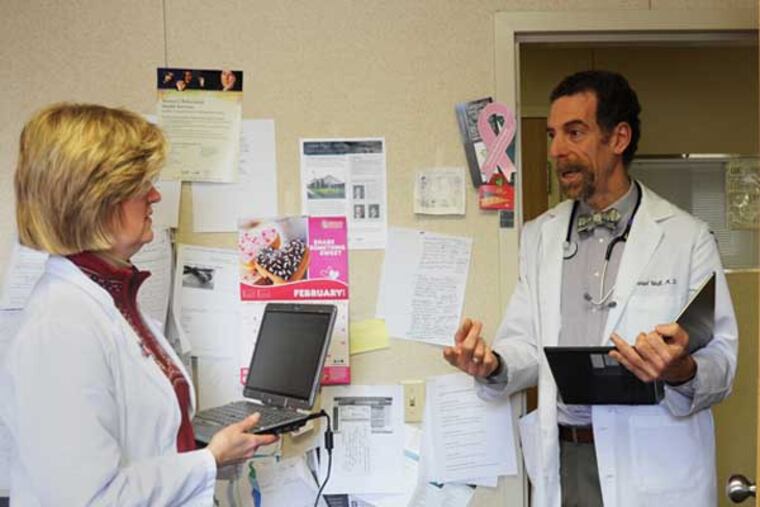Mixed messages from 'medical home' study
The biggest, broadest study of one of the hottest new trends in health care - the patient-centered "medical home" - found almost no benefits, researchers reported Tuesday. Yet neither they nor other experts saw the results of their three-year study, involving more than 100,000 patients in Philadelphia and its suburbs, as primarily negative.

The biggest, broadest study of one of the hottest new trends in health care - the patient-centered "medical home" - found almost no benefits, researchers reported Tuesday. Yet neither they nor other experts saw the results of their three-year study, involving more than 100,000 patients in Philadelphia and its suburbs, as primarily negative.
Indeed, Independence Blue Cross, which took part in the study and saw early results coming in several years ago, revamped its payments to primary care providers. Officials said they will report significant savings and better health measures in research to be published in the coming months.
Southeastern Pennsylvania "was our baby guinea pig," said Ann Torregrossa, who oversaw the program for the state early on.
The medical home model is centered more on the patient. It charges the primary care doctor with taking more responsibility for all aspects of care, from coordinating with specialists to ensuring that patients who haven't come in for a while didn't fall through the cracks. Patients become healthier; everyone saves money.
That's the theory. With pretty much all major players in the U.S. health-care system favoring the concept, they have proliferated so fast - hundreds of practices are now recognized as official medical homes locally - that effectiveness research has not been able to keep up.
Pennsylvania's Chronic Care Initiative was the nation's largest pilot when it began in 2008, rolling out first in the Southeast and eventually including more than 170 practices with 1.2 million patients statewide. Six insurers took part in the Southeast - a crucial ingredient, since medical homes involve offering incentives for doctors to make costly changes, such as hiring staff to follow patients.
Writing in the Journal of the American Medical Association, the authors said they collected data on 32 participating primary care practices, comparing their performance with that of 29 other practices. They tracked quality, use, and cost.
Only one measure improved: screening for diabetes-related kidney disease.
Calling the study "a failure would be the wrong interpretation," said lead author Mark Friedberg, of the RAND Corporation. "You should look at the ingredients of this Philadelphia pilot and say, 'What are we going to add and do differently?' "
One obvious lesson: Don't try to prove cost savings by studying all patients rather than, say, just those with chronic illness who use more medical care, said Bruce Landon, a professor of health-care policy at Harvard Medical School.
"Last year I never saw a specialist, never went to the emergency room. Are you going to see cost savings for me? Never. There aren't any costs to save," he said.
Landon still believes that medical homes offer benefits for a primary care system "in desperate need of reform."
Even as the state program rolled north and west through Pennsylvania, several parts have changed.
In the initial model, providers were given incentives for being recognized as medical homes by a national quality group. So they first focused on that time-consuming process, including restructuring their offices and creating databases.
Now there is a greater emphasis on managing patients' care, which often means using the money to hire a case manager. And the latest iteration is designed to allow providers and insurers to share in any cost savings.
One key hurdle - not yet solved - is that primary care providers often are not told when their patients are hospitalized or visit the ER.
Independence Blue Cross is trying to attack that with an online database of hospital census reports, chief medical officer Richard Snyder said. It also has reworked its reimbursement model, allowing providers to double their revenue if they meet quality measures and also save costs.
Snyder said that studies of its model that will be published soon including one that found a 21 percent savings in cost of care for diabetic patients. Quality measures improved as well, he said.
Everyone agreed the state initiative was a lot of work, especially for small practices.
It was too much for Dan Orr, a family physician in Chester County, who dropped out after the study.
He said he lost money seeing two or three patients an hour rather than the usual four, and was frustrated doing a lot of unnecessary "clerical work."
But Daniel Wolk, a family physician in a four-doctor practice in Broomall, said it had "reenergized my day-to-day life as a physician" after 25 years.
Practices were required to create registries of all their diabetic patients, for example, recording information like how many had their blood sugar under control. The doctors had thought they were providing good diabetes care - but found that only those diabetics who were in good shape made regular appointments. Perhaps a third of the 280 total did not, and many were doing poorly.
"We were really shocked at just how many people we had not been keeping track of," Wolk said. Using the incentive money from the initiative, they hired a case manager and tracked many of them down.
215-854-2617